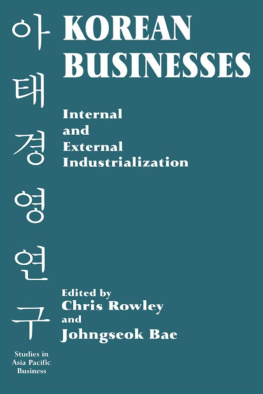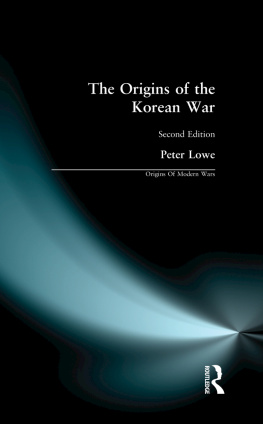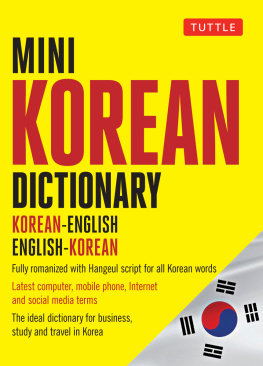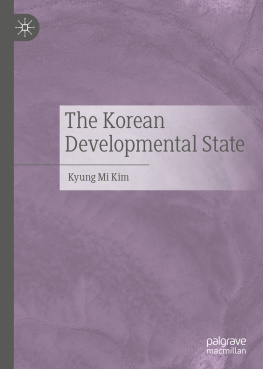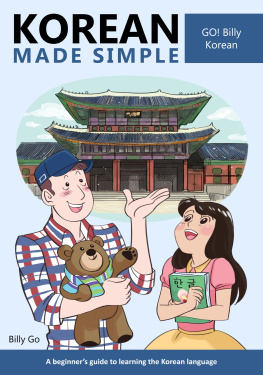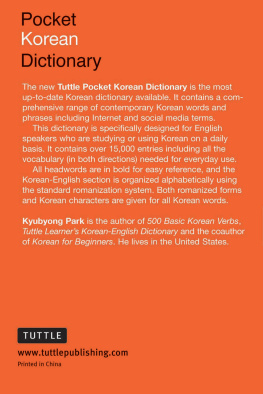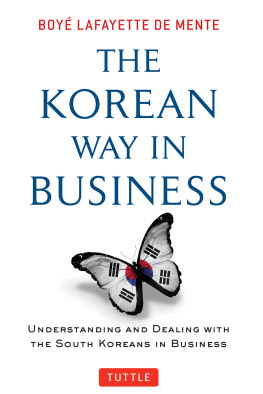KOREAN BUSINESSES
STUDIES IN ASIA PACIFIC BUSINESS
ISSN 1369-7153
General Editors: Robert Fitzgerald, Chris Rowley and Paul Stewart
Greater China: Political Economy, Inward Investment and Business Culture
Edited by Chris Rowley and Mark Lewis
Beyond Japanese Management: The End of Modern Times?
Edited by Paul Stewart
Management in China: The Experiences of Foreign Businesses
Edited by Roger Strange
Human Resource Management in the Asia Pacific Region: Convergence Questioned
Edited by Chris Rowley
Korean Businesses: Internal and External Industrialization
Edited by Chris Rowley and Johngseok Bae
KOREAN BUSINESSES:
Internal and External Industrialization
Edited by
CHRIS ROWLEY
City University Business School, London
and
JOHNGSEOK BAE
Hanyang University, Seoul
First published in 1998 in Great Britain by
FRANK CASS AND COMPANY LIMITED
Newbury House, 900 Eastern Avenue, London IG2 7HH, England
and in the United States of America by
FRANK CASS
c/o ISBS, Inc.
5804 N.E. Hassalo Street, Portland, Oregon 97213-3644
Transferred to Digital Printing 2004
Website: http://www.frankcass.com
Copyright 1998 Frank Cass & Co. Ltd.
British Library Cataloguing in Publication Data
Korean businesses : internal and external
industrialization. (Studies in Asia Pacific business)
1. Business enterprises Korea 2. Korea Economic conditions
I. Rowley, Chris, 1959- II. Bae, Johngseok
330.9519
ISBN 0 7146 4483 8
ISBN 0 7146 4924 4 (hbk)
ISBN 0 7146 4483 8 (pbk)
ISSN 1369-7153
Library of Congress Cataloging-in-Publication Data
Korean businesses : internal and external industrialization / edited by Chris Rowley and Johngseok Bae.
p. cm. (Studies in Asia Pacific business, ISSN 1369-7153)
This group of studies first appeared in a special issue of Asia Pacific business review, vol. 4, nos 2&3, winter 1997/spring 1998--verso t.p.
Includes index.
ISBN 0-7146-4924-4. ISBN 0-7146-4483-8 (pbk.)
1. Industrialization-Korea (South) 2. Korea (South)-Economic conditions-20th century. 3. Electronic industries-Korea (South) 4. Corporations, Korean. 5. Industrial management-Korea (South) I. Rowley, Chris, 1956- . II. Bae, Johngseok. III. Series. HC467.K619864 1998
338.95195-dc21 | 98-26372 CIP |
This group of studies first appeared in a Special Issue of Asia Pacific Business Review (ISSN 1360-2381), Vol. 4, Nos 2&3 (Winter 1997/Spring 1998) [Korean Business: Internal and External Industrialization].
All rights reserved. No part of this publication may be reproduced, stored or introduced into a retrieval system or transmitted, in any form or by any means, electronic, mechanical, photocopying, recording or otherwise, without the prior written permission of the publisher of this book.
DEDICATION
To the memory of Anne Rowley, 1907-1997: A wonderful matriarch missed by many
Contents
CHRIS ROWLEY and JOHNGSEOK BAE |
JOHN CATHIE |
ROBERT J. CASTLEY |
MIKE HOBDAY |
YOUNGSOO KIM |
ROGER VAN HOESEL |
CHRIS ROWLEY and JOHNGSEOK BAE |
CHRIS ROWLEY AND JOHNGSEOK BAE
Chris Rowley, City University Business School, London; Johngseok Bae, Hanyang University, Korea.
Some writers argue that modem history reveals that countries pass through cycles in economic leadership. The forerunners of industrialization used inventions and innovations as the major sources of their growth. On the other hand, newly industrializing countries, labelled latecomers vis--vis the first groups, relied more on imitating, borrowing, or learning advanced technological and organizational capabilities to achieve national industrialization and eventually to gain national competitiveness. For some time, many have viewed such economies, especially the Asian Tigers, as a major force that will lead future world economic growth. However, such expectations have diminished with the recent financial crisis and contagion in Asia. The subject matter covered here includes the sources of economic growth and industrialization, the catch-up strategies of firms, and foreign investment. The causes of the recent financial crisis, and future possibilities for the Korean model of business and management, are also analysed.
For some time, many have viewed newly industrializing economies (NIEs), especially the Asian Tigers, as a major force that will lead world economic growth in the coming era, with much talk of a Pacific Century and economies poised to leap ahead of those of the US and Europe. Much in Asia has inspired pride at home and envy abroad. Such expectations have diminished in the wake of the recent financial crisis in many Asian countries (see Cathie1 in this volume). Thus, plunging currencies and stockmarkets, and swelling foreign debt burdens in local currencies have put the economic miracle in deep freeze (The Economist, 1998: 3). Numerous news items are somewhat cynically headlined from miracle to crisis or from tiger to beggar. Self-confidence has evaporated with stories of people handing over gold jewellery to boost foreign reserves! However, it is useful to remember that there is no one Asian model; the economies hugely differ in structure and political systems and policies pursued (The Economist, ibid.; Cathie).
Some writers argue that modem history reveals cycles in economic leadership among countries (Kennedy, 1987; Kogut, 1993). Lazonick (1991) contends that the first three leaders possessed different types of capitalism: Britain was associated with proprietary capitalism, Germany and the US with managerial capitalism, and Japan with collective capitalism. Britain, Germany and the US, as forerunners in the process of industrialization, used inventions and innovations as major sources of capability creation (see van Hoesel). On the other hand, NIEs, following different routes of industrialization, have been called latecomers (vis--vis the first group2). Latecomers relied more on imitating, borrowing or learning advanced technological and organizational capabilities to achieve their national industrialization and eventually to gain national competitiveness (now a trendy, though nebulous, concept3). Such growth is seen to stem from several sources.
This volume is focused on the Korean4 model of industrialization and economic growth, internationalization, organizational capabilities and management, and inherent disadvantages. The subject matter covered includes the sources of growth and industrialization, the catch-up strategies of firms, foreign investment, and the causes of the recent financial crisis and future possibilities. This introductory piece has been written to provide a contextual introduction to the topic with four main sections. A brief summary of the driving forces underpinning Korean industrialization and economic growth is followed by the perspectives and main contents of the volume. For reasons of topicality, the next section deals with the recent financial crisis, and links are made to longer term trends. Finally, some concluding points are made.

